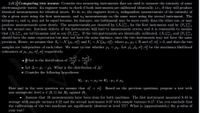
MATLAB: An Introduction with Applications
6th Edition
ISBN: 9781119256830
Author: Amos Gilat
Publisher: John Wiley & Sons Inc
expand_more
expand_more
format_list_bulleted
Concept explainers
Question
thumb_up100%
PLEASE SOLVE ALL PARTS

Transcribed Image Text:(d)|Comparing two means: Consider two measuring instruments that are used to measure the intensity of some
electromagnetic waves. An engineer wants to check if both instruments are calibrated identically, i.e., if they will produce
identical measurements for identical waves. To do so, the engineer does n1 independent measurements of the intensity of
the a given wave using the first instrument, and n2 measurements on the same wave using the second instrument. The
integers n, and n2 may not be equal because, for instance, one instrument may be more costly than the other one, or may
produce measurements more slowly. The measurements are denoted by {X;}"", for the first instrument and by {Y;}"1
for the second one. Intrinsic defects of the instruments will lead to measurement errors, and it is reasonable to assume
that {X;}1 are iid Gaussian and so are {Y;}"1- If the two instruments are identically calibrated, {X;}"1 and {Y;}"2,
should have the same expectation but may not have the same variance, since the two instruments may not have the same
precision. Hence, we assume that X; ~ N (µ1,07) and Y; ~ N (µ2, 0), where 41, 42 E R and of,o > 0, and that the two
samples are independent of each other. We want to test whether # = #2. Let i1, fî2, ož, o? be the maximum likelihood
estimators of µ1, 2, of, ož respectively.
What is the distribution of
+
of
Let A = î – jîz. What is the distribution of A?
Consider the following hypotheses:
Ho : H1 = #2 vs H : µ1# µ2
Here and in the next question we assume that of = o3. Based on the previous questions, propose a test with
non-asymptotic level a e (0,1) for Họ against H1.
Assume that 10 measurements have been done for both machines. The first instrument measured 8.43 in
average with sample variance 0.22 and the second instrument 8.07 with sample variance 0.17. Can you conclude that
the calibrations of the two machines are significantly identical at level 5%? What is (approximately) the p-value of
your test?
Expert Solution
This question has been solved!
Explore an expertly crafted, step-by-step solution for a thorough understanding of key concepts.
Step by stepSolved in 4 steps with 1 images

Knowledge Booster
Learn more about
Need a deep-dive on the concept behind this application? Look no further. Learn more about this topic, statistics and related others by exploring similar questions and additional content below.Similar questions
arrow_back_ios
arrow_forward_ios
Recommended textbooks for you
 MATLAB: An Introduction with ApplicationsStatisticsISBN:9781119256830Author:Amos GilatPublisher:John Wiley & Sons Inc
MATLAB: An Introduction with ApplicationsStatisticsISBN:9781119256830Author:Amos GilatPublisher:John Wiley & Sons Inc Probability and Statistics for Engineering and th...StatisticsISBN:9781305251809Author:Jay L. DevorePublisher:Cengage Learning
Probability and Statistics for Engineering and th...StatisticsISBN:9781305251809Author:Jay L. DevorePublisher:Cengage Learning Statistics for The Behavioral Sciences (MindTap C...StatisticsISBN:9781305504912Author:Frederick J Gravetter, Larry B. WallnauPublisher:Cengage Learning
Statistics for The Behavioral Sciences (MindTap C...StatisticsISBN:9781305504912Author:Frederick J Gravetter, Larry B. WallnauPublisher:Cengage Learning Elementary Statistics: Picturing the World (7th E...StatisticsISBN:9780134683416Author:Ron Larson, Betsy FarberPublisher:PEARSON
Elementary Statistics: Picturing the World (7th E...StatisticsISBN:9780134683416Author:Ron Larson, Betsy FarberPublisher:PEARSON The Basic Practice of StatisticsStatisticsISBN:9781319042578Author:David S. Moore, William I. Notz, Michael A. FlignerPublisher:W. H. Freeman
The Basic Practice of StatisticsStatisticsISBN:9781319042578Author:David S. Moore, William I. Notz, Michael A. FlignerPublisher:W. H. Freeman Introduction to the Practice of StatisticsStatisticsISBN:9781319013387Author:David S. Moore, George P. McCabe, Bruce A. CraigPublisher:W. H. Freeman
Introduction to the Practice of StatisticsStatisticsISBN:9781319013387Author:David S. Moore, George P. McCabe, Bruce A. CraigPublisher:W. H. Freeman

MATLAB: An Introduction with Applications
Statistics
ISBN:9781119256830
Author:Amos Gilat
Publisher:John Wiley & Sons Inc

Probability and Statistics for Engineering and th...
Statistics
ISBN:9781305251809
Author:Jay L. Devore
Publisher:Cengage Learning

Statistics for The Behavioral Sciences (MindTap C...
Statistics
ISBN:9781305504912
Author:Frederick J Gravetter, Larry B. Wallnau
Publisher:Cengage Learning

Elementary Statistics: Picturing the World (7th E...
Statistics
ISBN:9780134683416
Author:Ron Larson, Betsy Farber
Publisher:PEARSON

The Basic Practice of Statistics
Statistics
ISBN:9781319042578
Author:David S. Moore, William I. Notz, Michael A. Fligner
Publisher:W. H. Freeman

Introduction to the Practice of Statistics
Statistics
ISBN:9781319013387
Author:David S. Moore, George P. McCabe, Bruce A. Craig
Publisher:W. H. Freeman